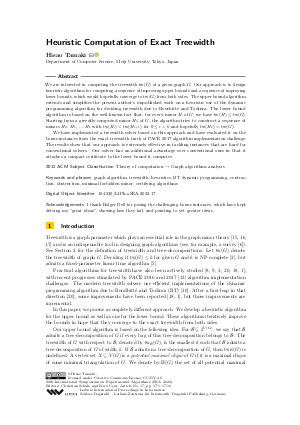@InProceedings{tamaki:LIPIcs.SEA.2022.17,
author = {Tamaki, Hisao},
title = {{Heuristic Computation of Exact Treewidth}},
booktitle = {20th International Symposium on Experimental Algorithms (SEA 2022)},
pages = {17:1--17:16},
series = {Leibniz International Proceedings in Informatics (LIPIcs)},
ISBN = {978-3-95977-251-8},
ISSN = {1868-8969},
year = {2022},
volume = {233},
editor = {Schulz, Christian and U\c{c}ar, Bora},
publisher = {Schloss Dagstuhl -- Leibniz-Zentrum f{\"u}r Informatik},
address = {Dagstuhl, Germany},
URL = {https://drops.dagstuhl.de/entities/document/10.4230/LIPIcs.SEA.2022.17},
URN = {urn:nbn:de:0030-drops-165512},
doi = {10.4230/LIPIcs.SEA.2022.17},
annote = {Keywords: graph algorithm, treewidth, heuristics, BT dynamic programming, contraction, obstruction, minimal forbidden minor, certifying algorithms}
}

 Creative Commons Attribution 4.0 International license
Creative Commons Attribution 4.0 International license

















